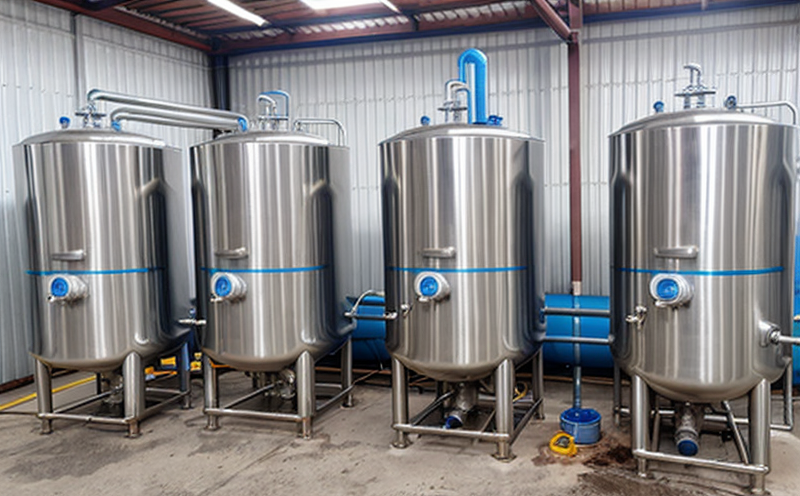ASTM D3559 Lead Test in Boiler Water
The ASTM D3559 standard method is widely recognized and used by industries that handle boiler water to ensure compliance with regulatory standards and maintain the safety and efficiency of their systems. This test specifically measures lead levels, which can indicate potential issues within a cooling or boiler system. Lead contamination in boiler water can result from various sources such as corrosion of metallic parts, scale buildup, or even the use of untreated water supplies.
Lead is a toxic metal that can pose serious health risks if it enters the drinking water supply through corroded plumbing fixtures or other sources. In boiler systems, lead can dissolve into the water and affect not only the integrity of the system but also the quality of the steam produced. Compliance with ASTM D3559 ensures that industries are aware of these potential hazards and take appropriate measures to mitigate them.
The test procedure described in ASTM D3559 involves several steps, including sample collection, preparation, digestion, and analysis using atomic absorption spectrophotometry (AAS). This method is chosen for its precision and accuracy in detecting trace amounts of lead. The standard specifies detailed guidelines on the correct sampling techniques to ensure that the results are representative of the entire system.
The testing process begins with the collection of a representative sample from the boiler water supply. Proper sampling is crucial as it ensures that the test accurately reflects the conditions within the system. After collection, the sample undergoes digestion in a strong acid medium followed by dilution and transfer to an AAS instrument for analysis.
The primary outcome of this testing procedure is the quantification of lead concentration in parts per billion (ppb). The results provide critical insights into whether the water quality meets the required standards. This information is essential for maintenance planning, system optimization, and ensuring compliance with relevant regulations such as ISO 14001 and EN 779.
Understanding the significance of lead in boiler water involves recognizing its role in both operational efficiency and environmental impact. Lead contamination can lead to scaling, which reduces heat transfer efficiency. Additionally, it poses health risks if it reaches drinking water supplies through steam condensate or other means. By adhering to ASTM D3559, industries can prevent these issues and maintain a safe work environment.
In summary, the ASTM D3559 Lead Test in Boiler Water is an indispensable tool for ensuring that boiler systems operate efficiently and safely. It provides essential data on lead levels, which are critical for maintaining compliance with international standards like ISO 14001 and EN 779. The test's precision and accuracy make it a trusted method within the industry.
Why It Matters
The importance of the ASTM D3559 Lead Test in Boiler Water cannot be overstated, especially for industries that rely heavily on boiler systems for their operations. By detecting lead contamination early, businesses can prevent costly repairs and ensure long-term system integrity.
- Operational Efficiency: Lead contamination leads to scaling, which reduces heat transfer efficiency. This results in increased fuel consumption and operational costs.
- Health and Safety: Lead is a toxic metal that can pose significant health risks if it enters the drinking water supply through steam condensate or other means. Regular testing ensures compliance with international safety standards like ISO 14001 and EN 779.
- Regulatory Compliance: Industries must comply with various regulations to ensure the safety of their products and services. ASTM D3559 provides a standardized method for detecting lead, ensuring that businesses are in line with these requirements.
- Sustainability: By preventing lead contamination, industries can contribute to environmental sustainability by reducing waste and minimizing the risk of pollution.
In conclusion, the ASTM D3559 Lead Test in Boiler Water is not just a compliance requirement but also a proactive measure that enhances operational efficiency, ensures health and safety, supports regulatory standards, and promotes sustainability. It is an essential tool for maintaining boiler systems and ensuring their safe and efficient operation.
International Acceptance and Recognition
The ASTM D3559 Lead Test in Boiler Water enjoys widespread international acceptance due to its robust methodology and stringent guidelines. This standard is recognized by numerous regulatory bodies worldwide, including the International Organization for Standardization (ISO) and European Committee for Standardization (CEN).
- United States: ASTM D3559 is widely adopted in industries such as power generation, chemical processing, and manufacturing.
- Europe: The standard aligns with European regulations like EN 779, ensuring seamless compliance across the continent.
- Australia/New Zealand: Compliance with ASTM D3559 is recognized in both countries, supporting global supply chains.
The consistent and reliable results produced by this test method make it a preferred choice for industries operating globally. Its acceptance ensures that businesses can confidently adhere to international standards without compromising on quality or safety.
Environmental and Sustainability Contributions
The ASTM D3559 Lead Test in Boiler Water plays a crucial role in supporting environmental sustainability by ensuring the safe operation of boiler systems. By detecting lead contamination early, industries can take proactive measures to prevent scaling and other issues that arise from lead intrusion.
Lead contamination not only affects operational efficiency but also poses significant risks to human health if it enters the drinking water supply through steam condensate or other means. Regular testing ensures compliance with international safety standards like ISO 14001 and EN 779, thereby promoting a safer and healthier environment.
By adhering to ASTM D3559, industries can contribute to environmental sustainability by reducing waste and minimizing the risk of pollution. This proactive approach helps in maintaining long-term system integrity while ensuring compliance with international standards.
In summary, the ASTM D3559 Lead Test in Boiler Water is an essential tool for promoting operational efficiency, ensuring health and safety, supporting regulatory standards, and fostering environmental sustainability. It is a vital component of any comprehensive quality management strategy.





